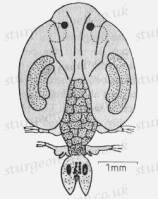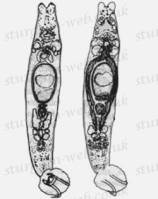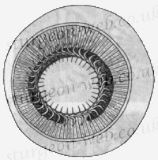Sturgeon Parasites
These are videos and drawings of the most common parasites found on sturgeons. There are others but these cause most of the problems. I hope these pictures will help you to identify the correct treatment for your fish. You may find a combination of parasites and some treatments will not kill all of them. If you can only find one or two parasites on any one fish you probably don't need to treat them, but watch the fish carefully. If on the other hand there are lots then treat now!
You may need to speak to a veterinary surgeon to confirm your diagnosis and treatment.
Fish Louse (Argulus)
Video of Fish Louse (Argulus) by Kannan Abdullah
A copepod; can grow up to 10mm in length. It inflicts its damage by biting the fish and injecting a poison so it can suck blood. It tends to feed in sheltered places on the fish with good blood supplies, such as the base of the fin or around the mouth.

Argulus
The parasite then swims off to find another host; it can fast for up to 3 weeks between meals. It's biggest problem is not only the injection of poison but the wound left behind which quite often leads to a secondary infection such as fungus or bacteria.
The parasite is sexually mature after 5-6 weeks sucking blood; it then swims off to find a mate. When it has laid its eggs they hatch in about 4 weeks leading to a life cycle of 8-9 weeks. This can make treating them difficult, as the course of treatments can be quite long.
As sturgeons do not tolerate the treatments well either this can make it a real problem. The best way is to remove the fish and treat the pond/tank then put the fish back.
Flukes (Gyrodactylidae)
Video of Gill Fluke (Dactylogyrus) by Paul K. Vaughn
Gyrodactylus has two hooks one end of the body and a sucking disc at the other. It feeds on the blood and skin debris, is more often found on the skin but does occur in the gills.

Gyrodactylus
Spreads by floating off and being passed through the gills of another fish where they can then get hold and move to the skin.
Flukes reproduce relatively slowly as only one animal is born at a time. They are very small, less than 0.8mm long; most are less than 0.5mm in length.
Best Treatment: Salt bath, 2oz per gallon in a bowl with aeration. For 15-20 minutes.
Trichodina
Video of Trichodina by Michel VEROLET
There are many species in this group but all look similar and are difficult to distinguish between. So this is a generalisation about all of them. They are frequently found in very large numbers when the fish has been weakened first by other causes.

Trichodina
These hat shaped parasites are easy to spot (under a microscope) as they have cilia (hairs used to move around with) around the edge and an arrangement of teeth like a circular saw in the centre.
They are very motile and move about the skin and gills of the fish.
They only cause superficial damage as a rule but if numbers are high enough and the fish is weak, death can occur. Quite easy to kill but often the treatment causes more stress than the parasite.
Check for other factors that may have caused the outbreak, such as poor water quality or low oxygen levels. If numbers get high the sturgeon will die.
Best Treatment: Salt bath, 2oz per gallon with extra aeration for 15-20 minutes.
Treatment Tips
There are 'off the shelf' treatments that can be used with sturgeon but you must follow the instructions and these simple tips.
Read the label, if in doubt check with the manufacturer. Yes, they do have to tell you what is in it (Health and safety). If they are unable or unwilling to say then avoid the treatment.
Treatments to avoid include:
- Copper sulphate, CuSo4.
- Organophosphates *
- Treatments containing Formalin / formaldehyde
- Potassium permanganate
- Any treatment that states not to be used with Golden Orfe (Leciscus sp.) or Rudd (Scardinius reythrophathalmus) is more than likely to kill sturgeon.
![[This work is copyright © 2000-2024 www.sturgeon-web.co.uk]](img/copyright.gif)
* These chemicals can be dangerous to humans and have been banned in the U.K.![]()
Tips:
- Don't feed during treatment as eating requires the fish to absorb extra oxygen to digest the food. If you can don't feed for a day before and a day after treatments.
- NEVER treat in the evening, if something goes wrong you will not know until the morning then it could be to late!
- Add extra aeration; some treatments will deplete the oxygen levels.
- NEVER mix algae and fish treatments, it will go wrong!
Other items to remember:
- Check your water quality before you treat to make sure the water is not the cause; if it is cure this problem first. There is no point treating if the water quality is poor, as the fish will not recover before the next problem occurs!
- If you can, turn off the filter system, as some treatments will kill the filter bacteria. Remember to have some water flow through the filter or it will die without oxygen.
- Vacuum the pond to remove any debris, as it will absorb and break down any chemicals you use.
- Remove any plants, as the chemicals may kill them.
- Check your dose before you put it in the pond. No guessing, the wrong does will either not work or kill the fish.
- Add treatments a bit at a time over an hour or so to make sure the fish can tolerate the dose you have measured out.
- Always finish a course of treatment.
NEVER OVER DOSE
When the treatment is over, check water quality (Ammonia, Nitrite) daily to make sure the filter is working well.
Drain your pond to half its normal volume before treatment, if you can. This uses less chemicals saving the environment and money. When finished top the pond up and any remaining chemicals will be diluted.
NEVER USE ANTIBIOTICS IN THE POND WATER
It will kill the filter bacteria and you will have more problems than you started with! Always take fish out to bathe and then return to the pond.
Written by Terry White & Graham Quick![]()
Contents
Home
Sturgeon Species
Sturgeon Care
Sturgeon Health
Water Quality
Our Other Sites

Copyright © 2000-2024
www.sturgeon-web.co.uk
All Rights Reserved.
Protected by UK Copyright Service Registration No:311386
